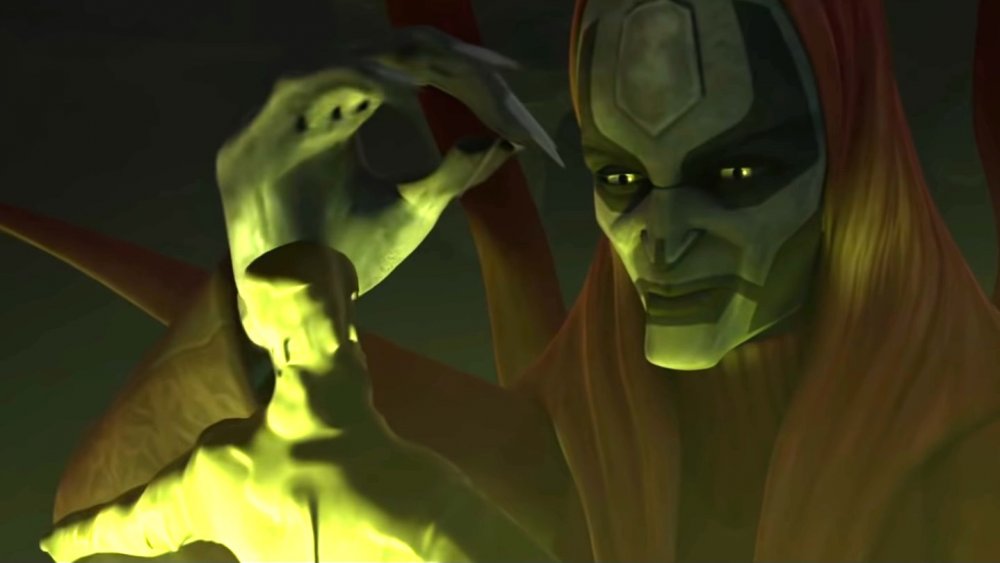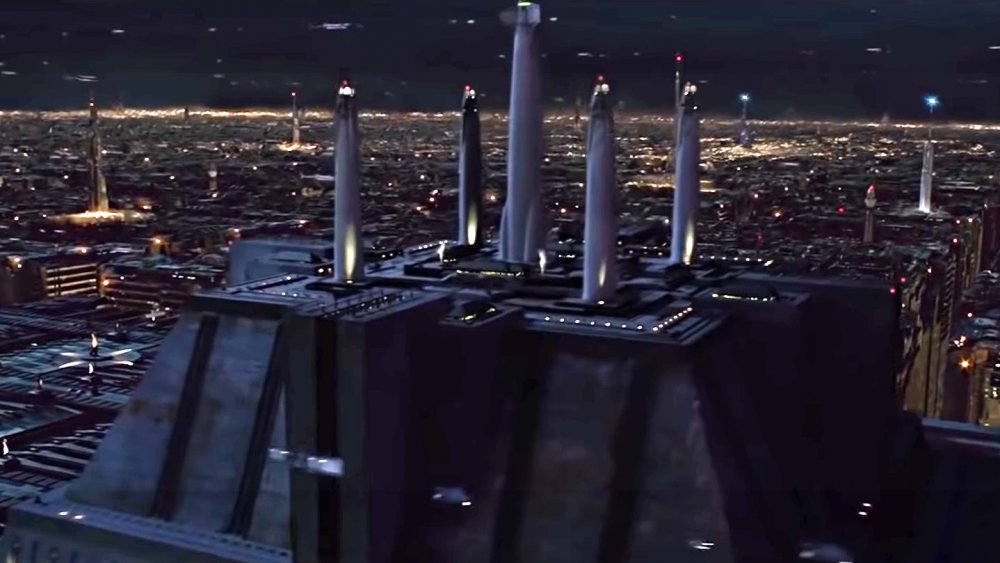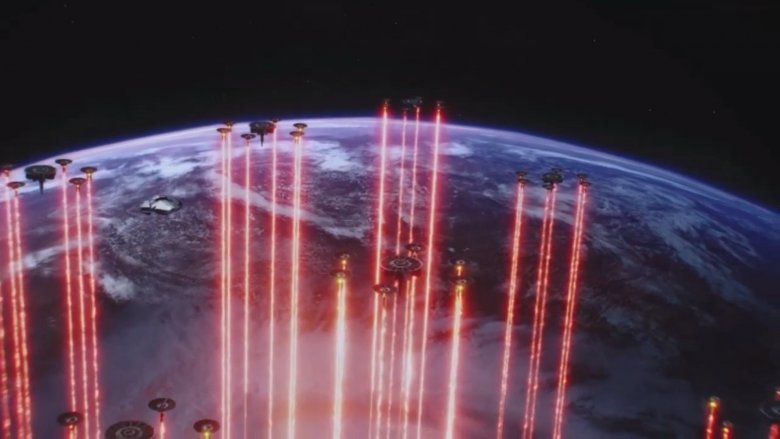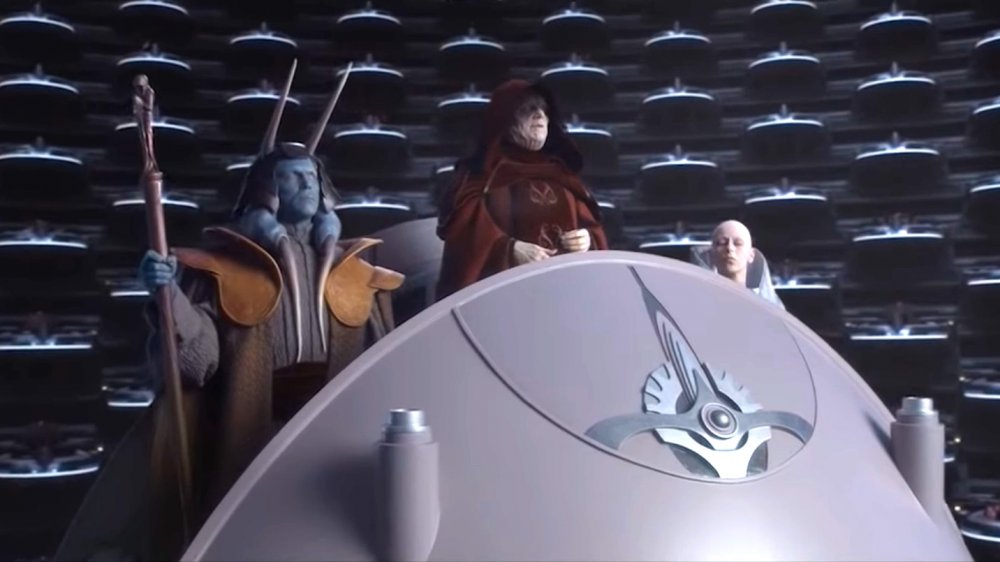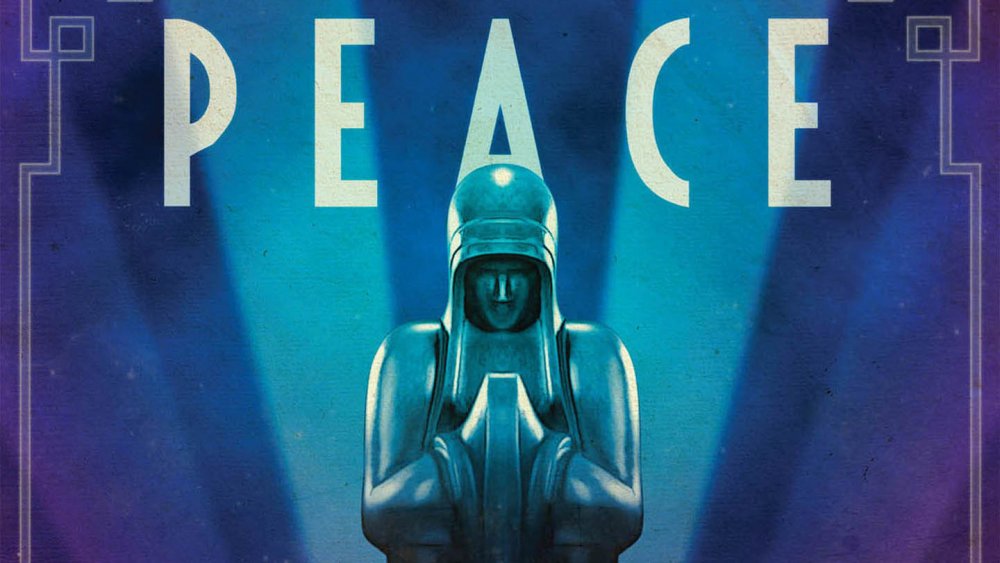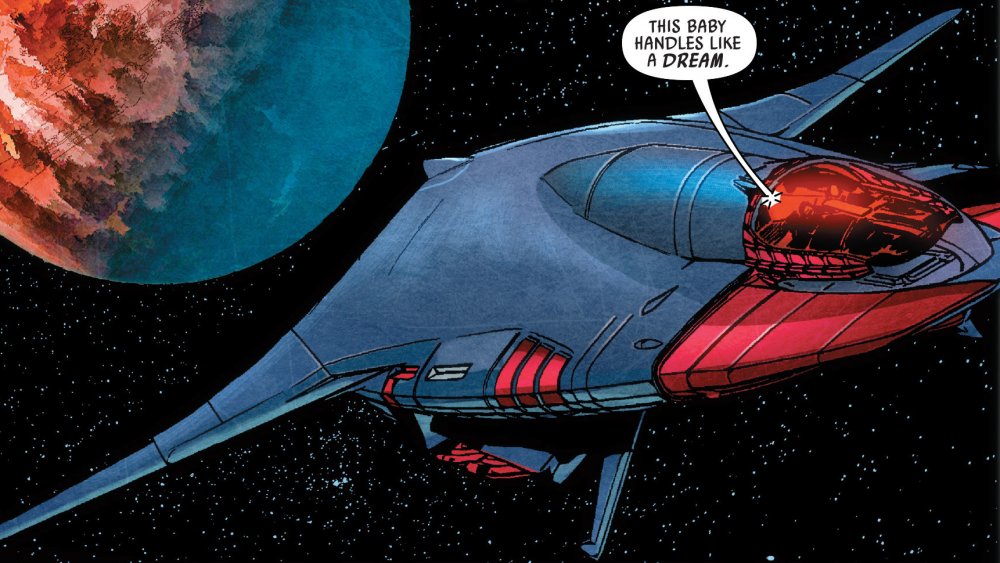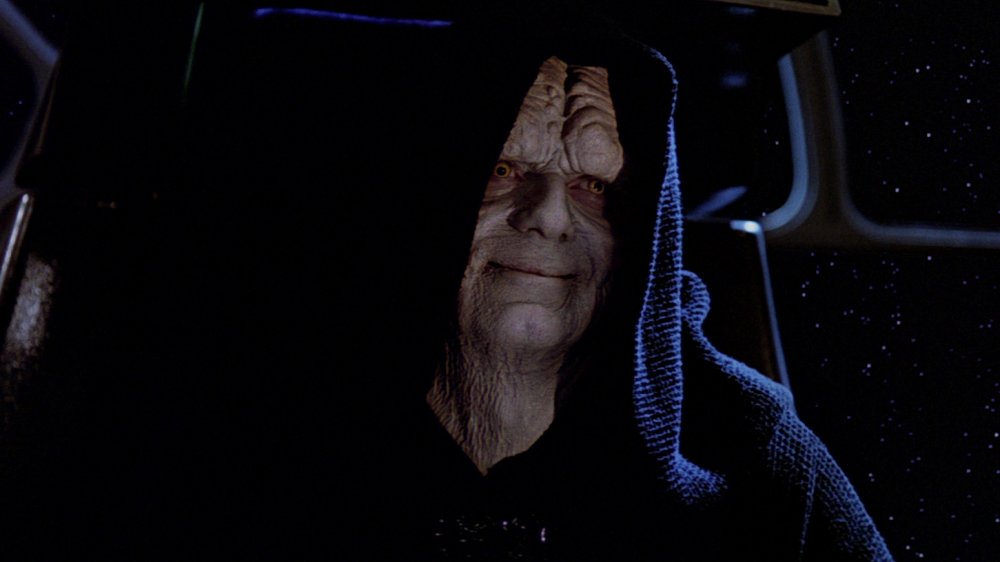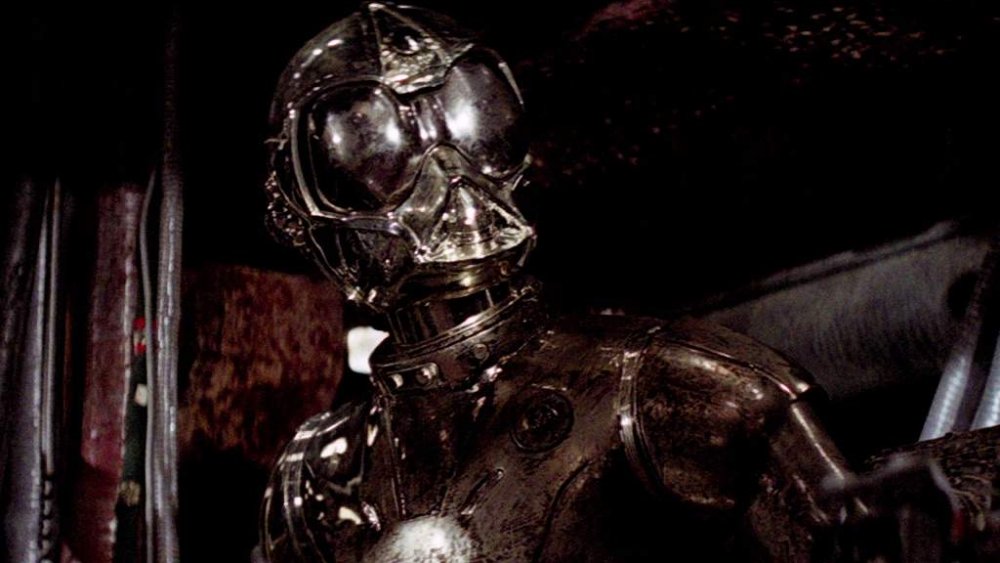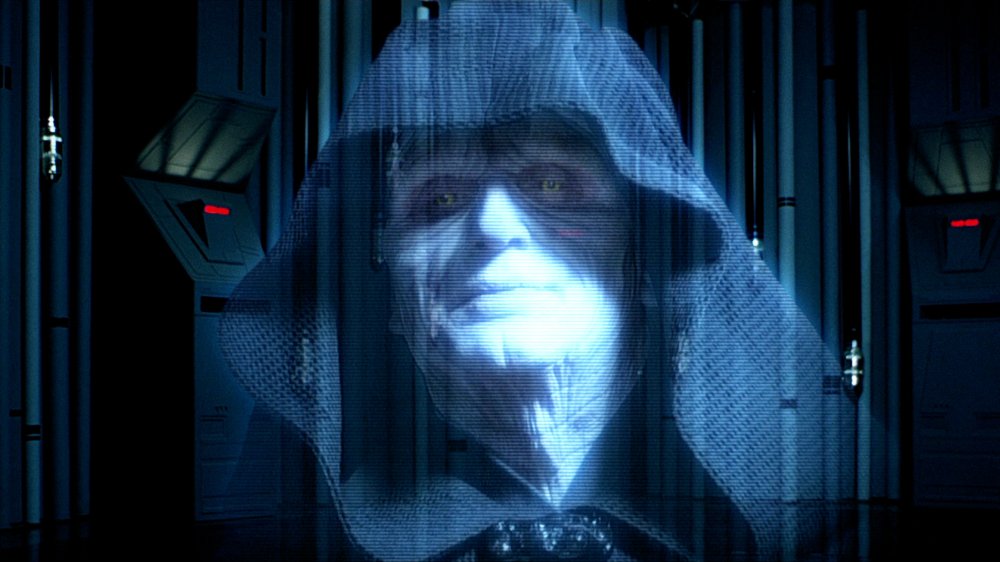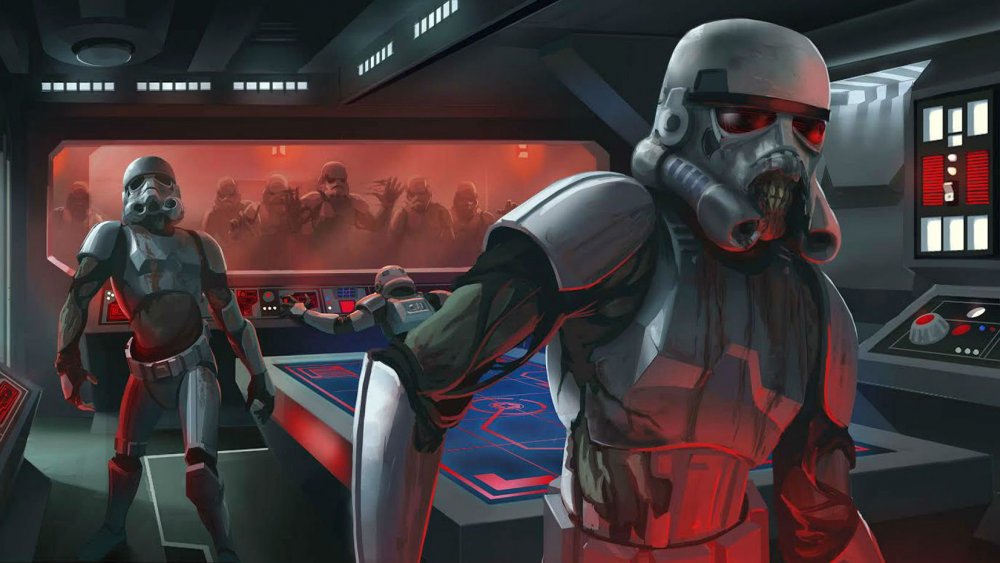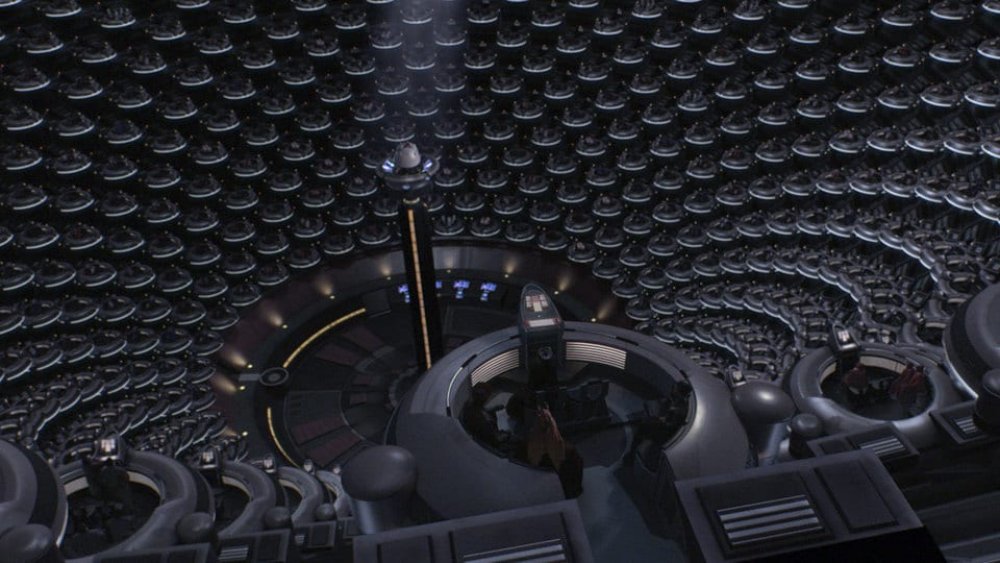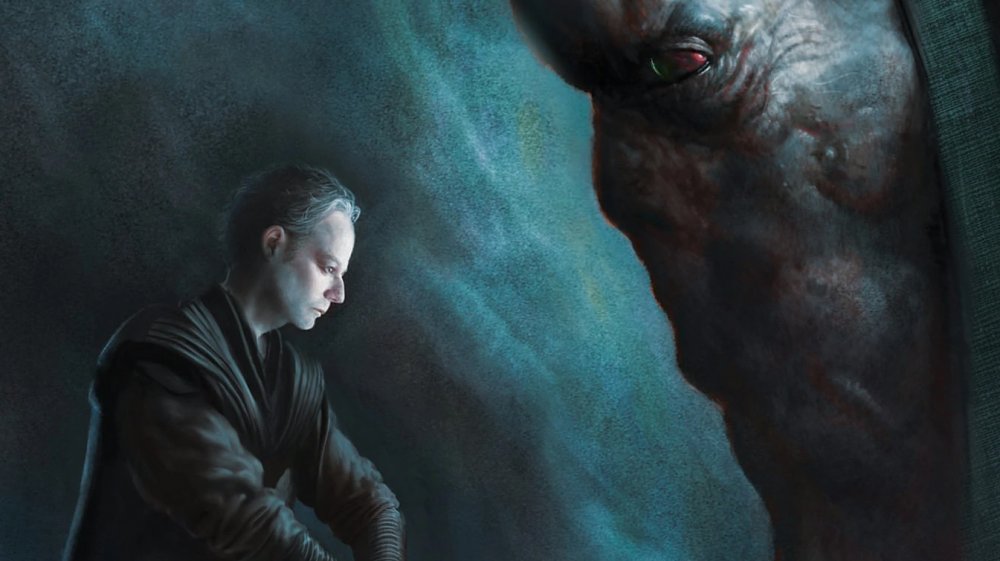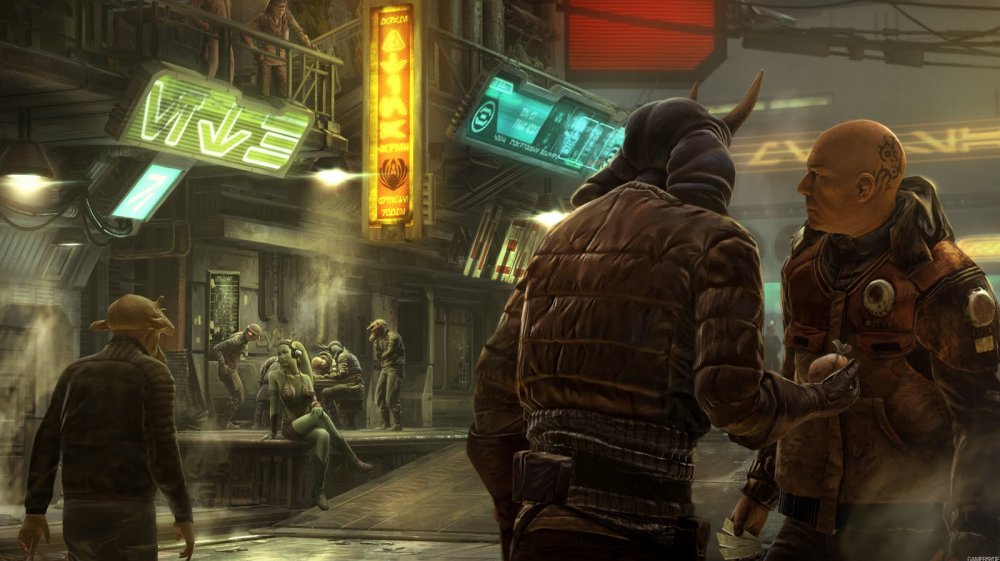The Untold Truth Of Emperor Palpatine
Sheev Palpatine, a.k.a. Darth Sidious, has always been an enigmatic character in Star Wars lore, a dark horse who methodically rose through the political ranks of the Galactic Republic to become Supreme Chancellor and ultimately Emperor. Although the prequel trilogy reveals how Palpatine engineered the downfall of the Jedi, much of his character is still shrouded in mystery.
The Phantom Menace establishes that Senator Palpatine hails from Naboo, but nothing more about his past or upbringing is explained. From Revenge of the Sith, fans learned that Sidious once had a master named Darth Plagueis, but how did the two meet? Why did they end up falling out? We see the Sith Lord use some powerful dark side abilities during the films, but just how many Force powers does the Emperor wield?
Despite being one of the most iconic villains of all time, Emperor Palpatine's history and motivations remain a mystery to countless Star Wars fans. This shadowy persona is part of what makes the Emperor such an effective antagonist, a mysterious puppet master pulling the strings from behind the scenes. However, there is much more to learn about Darth Sidious than the brief glimpses into his character offered by the films. This is the untold truth of Emperor Palpatine.
He had a complicated history with the Nightsisters
After becoming Darth Plagueis' apprentice, Palpatine traveled to Dathomir in order to trade his knowledge of the dark side with Mother Talzin. As Clan Mother of the Nightsisters, a tribe of Force-sensitive witches native to Dathomir, Talzin used her dark magick and connection to the spirit world to rule the planet with her coven. Sidious was impressed with her mastery of Magick, a supernatural technique that allowed her to tap into the dark side of the Force, and told Talzin he wished to train her as his apprentice to usurp Plagueis.
However, Palpatine saw Force potential in Talzin's son Maul, and instead abducted him. Talzin never forgave Sidious for taking Maul away from her, and began to plot her revenge against him. She used several children of Dathomir as tools to disrupt Darth Sidious' plans throughout the years, including Asajj Ventress, Savage Opress, and Maul himself. Eventually, Sidious had enough of Talzin's meddling and decided to deal with her. Sidious allowed Maul to think he had successfully captured Count Dooku but actually used him to track Dooku back to Mother Talzin's location. After ambushing the Dathomirians, Darth Sidious was able to overwhelm Mother Talzin with his lightning long enough for General Grievous to stab her with his lightsaber.
He desecrated the Jedi Temple on Coruscant
Not many Star Wars fans are aware of Emperor Palpatine's true connection with the Jedi Temple. Thousands of years before the formation of the Galactic Republic, the Sith erected a shrine on the planet Coruscant that emitted dark side energy. After defeating the Sith, the Jedi Order built the Jedi Temple directly over the foundations of the Sith shrine. This was done for two different reasons — to symbolically bury the legacy of the Sith and to neutralize the dark energy that the shrine radiated.
However, after Darth Sidious defeated the Jedi order, he converted what was left of the Jedi temple into his personal Imperial Palace and secretly excavated the Sith shrine. Palpatine had the unearthing of the shrine completed entirely by droids so that even Lord Vader would not be aware of its existence. The Emperor used the refurbished Sith shrine as his own private sanctum where he could meditate on the dark side of the Force, and was eventually planning on allowing Vader to join him. Together, he believed they could use the shrine's connection to the dark side to discover more Sith knowledge and powers.
He ordered the decimation of his own homeworld
Palpatine had no remorse for the people of his own home planet when he planned Operation Cinder, a contingency plan to ensure the longevity of the Galactic Empire should he ever be killed. Palpatine believed that if the Empire was unable to prevent his assassination, then the entire organization was a failure and did not deserve to live on without him. In order to fulfill his vision, Palpatine created a plan to annihilate both the Empire and its enemies should he ever perish, and entrusted a select group of Imperial officers with the duty of rebuilding a new Empire.
The plan was to use a series of satellites to form a climate disruption array capable of laying waste to resistance-allied planets with catastrophic weather events. After the Emperor's death during the Battle of Endor, one of these climate disruption arrays was used to wreak havoc upon Palpatine's home planet of Naboo. The satellites created massive hurricanes and electrical storms that ravaged the surface of the planet. It was only through the actions of Leia Organa and Lando Calrissian that the rebels were able to destroy the climate disruption arrays and stop the people of Naboo from being completely wiped out.
He kept powerful allies by his side
A brilliant tactician, Emperor Palpatine collected powerful supporters like Sly Moore and Mas Amedda to assist in his ascension to Supreme Chancellor. One of the only people to know of Sidious' dual identities, Sly Moore served as Supreme Chancellor Palpatine's senior administrative aide. Moore was a Force-sensitive female native of Umbara with the purported ability to manipulate the minds of others. Fiercely loyal to Sidious, there is no doubt she used her mental powers to influence the minds of government officials and advance her master's political agenda.
Another one of the chosen few advisers to learn of Sidious' true nature, Mas Amedda was a male Chagrian who served as Vice Chair of the Galactic Senate. Although he possessed no Force abilities like Moore, Amedda was a powerful political ally to Palpatine. He helped Palpatine consolidate power as a senator and orchestrated the success of his election for Supreme Chancellor. Amedda was also instrumental in blocking any attempts the Senate made to cease the Clone Wars before his master's plan reached completion. Amedda went on to become Grand Vizier of the Galactic Empire, an esteemed position putting him directly underneath the Emperor on the chain of command.
He created Anakin
A few years ago, one of the longest-running Star Wars fan theories was finally confirmed: Yes, Darth Sidious really did create Anakin Skywalker.
All of the clues had been there for a while, of course. In The Phantom Menace, Anakin's mother Shmi tells Qui-Gon Jinn that she became pregnant with Anakin without the help of a father, while Qui-Gon discovers that young Anakin has an abnormally high midi-chlorian count. In Revenge of the Sith, Palpatine tells Anakin the story of his former master, Darth Plagueis, who figured out how to use midi-chlorians to create life. According to the book The Making of Star Wars Revenge of the Sith, Lucas actually wrote a scene making Anakin's parentage explicit, but the lines were cut from the final film.
Years later, Marvel's Darth Vader #25, which is canon, settled the issue. During a vision, Vader looks up at an image of Shmi and Palpatine as his iconic line "I am your father" rings in the background. He also sees Palpatine as Darth Sidious zap his mother's womb with dark side energy. There's enough wiggle room built in that Lucasfilm could retcon this if they want, but for now it's pretty clear: Palpatine is Darth Vader's daddy.
Before he was Emperor, he designed propaganda
Darth Sidious was a master Sith user and skilled fighter, but he didn't take over the Republic by force. He used trickery and deceit. As such, it's hardly surprising that Palpatine used his gift for psychological manipulation well before he was on the way to becoming Emperor, nor that he was one of the Galactic Senate's most skilled propagandists.
Palpatine's predecessor, Supreme Chancellor Valorum, was a weak-willed and indecisive leader who often kowtowed to special interests. In short, he wasn't up to the job. So, when Valorum needed to sway the hearts and minds of the people, he often offloaded his duties to everyone's favorite Sith-lord-in-hiding. The book Star Wars Propaganda, a collection of in-universe propaganda pieces, has some of Palpatine's work, including a striking invitation to the Republic's 1,000 year anniversary celebration.
Palpatine didn't stop meddling in the Republic's propaganda machine after he took power, either. When the Republic commissioned posters to bolster support for the Clone Wars, Palpatine explicitly forbade artists from producing materials featuring the Jedi. Publicly, Palpatine said that he didn't want to make the Jedi, who were already wary about being military leaders, more uncomfortable. Privately, Palpatine didn't want people siding with the Jedi, since he planned to scapegoat them as part of his coup once the war ended.
He built a bomb inside a planet to destroy the Empire
Death wasn't the end for Palpatine. Even after he died on the second Death Star, his plans lived on — and it turns out he was a "If I can't have it, no one can" type of guy.
Years before Palpatine crowned himself Emperor, he established an underground "observatory" on the planet Jakku, Rey's homeworld in The Force Awakens. His plan? Stuff it full of Sith relics with the power to cause an explosion and then, in the event of his death, detonate the whole thing and wipe out the Empire and the Rebel Alliance in one fell swoop. Any Empire that was inept enough to let Palpatine die didn't deserve to survive, Palpatine figured, and winnowing out the Empire's weaker elements would give it the freedom to reform into something stronger. If his enemies died in the explosion too? So much the better.
Palpatine put a man named Gallius Rex in charge of the plan, which unfolds in Chuck Wendig's Aftermath trilogy. It almost works. Rex manages to lure the Empire and the New Republic to Jakku for a final showdown, but a team of good and bad guys stop the planet from blowing up. Still, after the battle, the Empire heads off to the Unknown Regions to regroup, where it transforms into the lean and mean First Order. In the long term, mission accomplished.
He had his own space yacht — and it was stolen by Lando Calrissian
Palpatine looked down on luxury, preferring a spartan lifestyle that fit with his brutal Sith philosophy. Discomfort isn't great for impressing politicians, however, so Palpatine also maintained his own pleasure craft, which he called the Imperialis. He must've loved the ship a lot, too — every single one of Palpatine's secret observatories, which were home to the Sith lord's most treasured artifacts, contained a full replica of the craft.
The Imperialis was fast enough to outmaneuver a Star Destroyer, had all kinds of fancy weapons and defensive tools, and was stuffed full of treasure, making it a perfect target for smugglers and pirates — those who were dumb enough to take on the Emperor himself, anyway. Well, that description fits Lando Calrissian perfectly. In Marvel's Lando miniseries, Mr. Calrissian boosts the Imperialis and ends up on Palpatine's bad side.
While Palpatine sends Star Destroyers and bounty hunters after Lando, none of them can bring the Imperialis home, so Palpatine orders the ship destroyed. As Lando's crew succumbs to corruption from a Sith artifact, the bounty hunter Chanath Cha arms the Imperialis' self-destruct module. Lando, his sidekick Lobot, and Cha escape, but the Imperialis is lost forever.
Almost nobody knew Palpatine was a Sith
The Sith robes, saggy pale skin, and yellow eyes should've given it away, but even after Palpatine transformed the Republic into the Empire, he worked very hard to hide his Sith background. People knew (or, at the very least, rumors suggested) that Darth Vader was familiar with the ways of the Force. That Palpatine was his master was a tightly-guarded secret.
According to the books Lords of the Sith and Tarkin, only a few people were privy to what Palpatine was. His apprentices — Darth Maul, Count Dooku, and Darth Vader — knew, of course. So did his royal guards. Almost everyone else was kept in the dark. Even Grand Moff Tarkin, one of Palpatine's closest allies and most trusted confidants, only suspected that Palpatine was Sith. He didn't know for sure.
It's not clear why Palpatine didn't flaunt his Sith heritage, although it's easy to guess. For one, Palpatine spent his entire career operating in the shadows. Why start moving into the light now? For another, to Palpatine, information was power. There's no use in telling people more than they need to know. Every fact that's revealed can eventually be used against you.
He adopted his old master's droid
Lots of Palpatine's backstory comes from James Luceno's Darth Plagueis, which is no longer canon in Disney's new, streamlined Star Wars Universe. Still, Plagueis' legacy lives on in a few ways. The tragedy of Darth Plagueis the Wise is told in one of Revenge of the Sith's most memorable scenes. Plagueis' desire to conquer death plays a major role in Anakin's turn to the dark side, and could be a key factor in Palpatine's return in The Rise of Skywalker. Finally, while Palpatine killed Plagueis while his master slept, he did take a souvenir with him — 11-4D, Plagueis' trusty protocol droid.
11-4D wasn't a typical protocol droid, though. He had many arms, many of which had tools attached instead of hands. 11-4D also had more responsibility than most droids of his ilk. When Palpatine converted the old Jedi Temple into the Imperial Palace, for example, 11-4D was in charge of the excavation and restoration of a Sith shrine underneath, which came to be used as Palpatine's private lair.
In James Luceno's Tarkin, 11-4D plays a small but critical role in Tarkin's rise to power. By the Emperor's side, 11-4D helped interrogate prisoners and uncovered false holovids, which were being used to spread misinformation.
Many people thought he was dead
Palpatine didn't establish the Empire to get famous. He just wanted power. While serving as a senator made Palpatine a celebrity, he retreated from the public eye once he became emperor, letting the Imperial Ruling Council handle most of the day-to-day work of governing and leaving nastier tasks up to his apprentice, Darth Vader.
As a result, Palpatine was safe from his enemies and could devote as much time as he wanted to his own pursuits, but it had an unintended side effect: Because no one saw him, some conspiracy theorists argued that Palpatine was dead. The most common story alleged that the Jedi killed Palpatine during their "uprising," and that the Imperial leaders were using Palpatine's name to grab power for themselves.
The Empire tried to dispel these rumors in a few ways. In Tarkin, Tarkin's friend Nils Tenant admits that the Ruling Council sent out "processions of Imperial skylimos" — basically, fake flying motorcades — to make it look like Palpatine was traveling from place to place. In Aftermath, we learn that the Empire used body doubles to give the impression that Palpatine was giving speeches or making other public appearances. In reality, however, Palpatine preferred to stay at home — although he was very much alive.
He accidentally created zombies in his search for immortality
Like Darth Plagueis before him, Palpatine was obsessed with unlocking the secrets of immortality, which will probably play into his return in Star Wars: Episode IX — The Rise of Skywalker. However, not all of his experiments paid off. Just look at what happened to Project Blackwing: instead of discovering the key to everlasting life, the Empire accidentally created stormtrooper zombies.
In the mobile game Star Wars: Commander — which is canon, because under Disney, everything is — Palpatine recruits a bunch of "Sith scientists" to make Imperial soldiers live forever. Instead, they create a virus that turns the corpses into members of the living dead. The virus ultimately creates an entire army of so-called Death Troopers, but the combined forces of the Empire and the Rebel Alliance contain the outbreak, saving the galaxy from a zombie apocalypse.
Still, the Death Troopers' legacy lives on in one key way. Allegedly, the Death Troopers seen in Rogue One (who were special ops soldiers, not zombies) got their name from Palpatine's failed experiment. Hey, it's a good name. May as well use it twice.
He robbed the Senate of any real power but didn't bother to tell the Senate
Don't let anyone tell you that Palpatine didn't have a sense of humor. The way he treated the Senate proves that he does.
Despite what you might think, Palpatine didn't dissolve the Galactic Senate as soon as he took power. In fact, he kept it around for decades. Before the Death Star, Palpatine saw the Senate as a valuable political tool that let its constituents feel like they had some say in politics as a means of quashing potential rebellions. It was an illusion, of course. Over time, power moved from the Senate to local, regional leaders, robbing the politicians of any real influence. Once Palpatine created the Death Star, which would let the Emperor control the galaxy via fear instead of politics, he disbanded the Senate entirely, but that didn't happen until the beginning of A New Hope.
However, nobody bothered to let the senators know what was happening. In a comic in Star Wars Rebels Magazine, the crew of the Ghost runs into a senator from the planet Thrad, who still believes in the legislative body. The senators still debate policy, she says. They still pass bills, which they send to Palpatine to be signed into law. They don't realize that Palpatine simply ignores them. They think they're making a difference. Instead, they're frittering away in the Senate chamber, doing absolutely nothing. Heartbreaking? Kind of. Tragically hilarious? Oh, absolutely.
Midi-chlorians might've been the key to Palpatine's return
Incredibly, Star Wars: Episode IX — The Rise of Skywalker doesn't explain how Palpatine came back to life. He's simply there, in the Unknown Regions, manipulating everyone from behind the scenes. Sure, we get a few hints — those giant tubes containing Grand Admiral Snoke clones, or Dominic Monaghan's offhand remark about dark science — but the movie seems content to let us know that Palpy is back and let us fill in the blanks.
Or does it? At the beginning of the movie, Palpatine chats with Kylo Ren, and if you know your prequels his dialogue sounds very familiar. While discussing the Sith's abilities, Palpatine says that the devotees of the dark side have powers that "some consider to be unnatural."
Sound familiar? It should. That's exactly what Palpatine says when telling Anakin Skywalker the story of Darth Plagueis the Wise, Palpatine's former master, who discovered how to use midi-chlorians and the Force to cheat death — and who passed his secrets on to Palpatine. Obviously, that doesn't fill in any specifics about the mysterious resurrection, but it does make the Emperor's return feel a little less random. Palpatine has been planning this for a long, long time.
The identity of Palpatine's lover may already be decided
So, Palpatine had a son. That's the secret fueling The Rise of Skywalker's biggest twist, and it raises a number of questions — most importantly, who was that man's mother? Lucasfilm might already know. In 2005, George Lucas began working a live-action Star Wars TV show known as Star Wars: Underworld, which was going to focus on the seedy underbelly of the Star Wars universe, and was set between Episode III and Episode IV. About 50 scripts for the show were written, while LucasArts, Lucas' video game company, began work on a spinoff called 1313.
That's where things get interesting. According to Cory Barlog, who worked on 1313, Underworld featured a tragic love story starring the Emperor. "They made the Emperor a sympathetic figure who was wronged by this... heartless woman," Barlog tells VentureBeat. "She's this hardcore gangster, and she just totally destroyed him as a person."
Underworld never happened — first it was postponed due to its budget, and then Disney swooped in and changed everything — but elements from Underworld have made their way into modern Star Wars canon. Saw Guerrera, the hardcore revolutionary who appears in Rogue One, The Clone Wars, Rebels, and Jedi: Fallen Order was created for Underworld. So was The Force Awakens' Church of the Force, the entire premise of Rogue One, and many elements of Star Wars Rebels. Could Palpatine's mysterious lover join them? Knowing Lucasfilm, it sure doesn't seem impossible.

